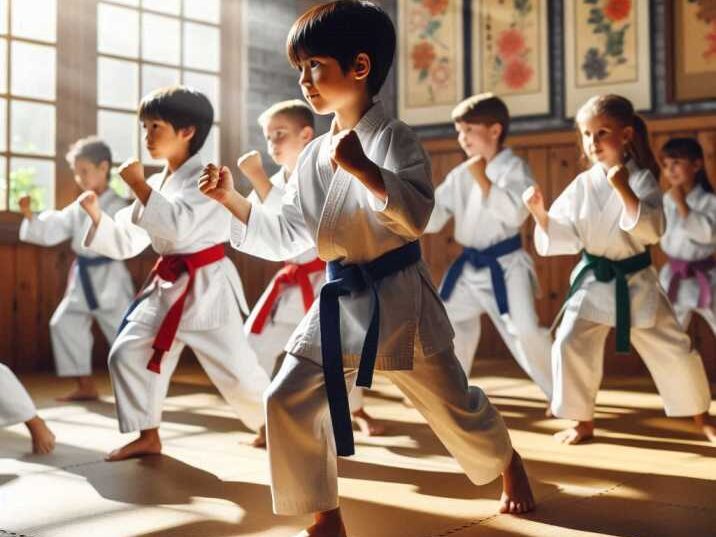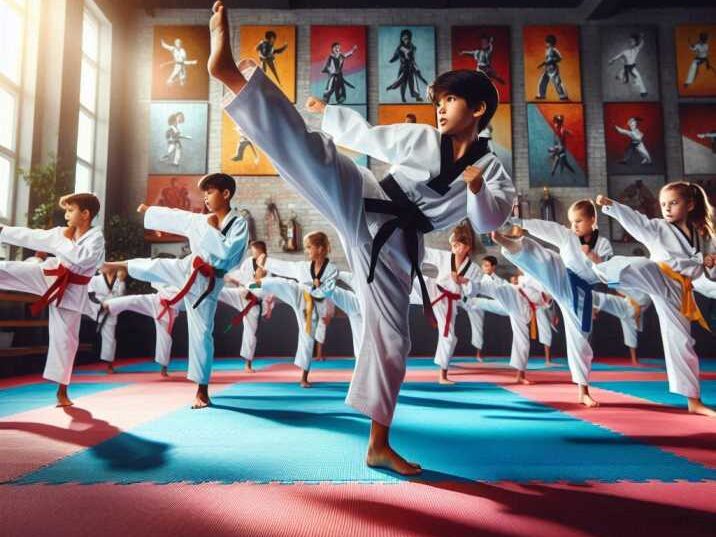Martial arts are one of the most rewarding activities children can take part in. Not only do they keep kids active and healthy, but they also help shape character, build confidence, and teach lifelong values like respect and discipline. Among the many martial arts available today, karate vs taekwondo stand out as the most popular for children.
Parents often find themselves asking: Which one is better for my child—karate or taekwondo?
The answer depends on your child’s personality, interests, and goals. Karate and taekwondo both have unique benefits, but they differ in style, history, teaching methods, and physical focus. Understanding these differences will make your decision much easier.
In this article, we’ll dive into what karate and taekwondo are all about, break down the 7 key differences every parent should know, and help you figure out which martial art is the best choice for your child.
What is Karate?
Table of Contents
Karate is a Japanese martial art that originated in Okinawa, heavily influenced by Chinese fighting systems. The word “karate” means “empty hand,” which reflects its focus on self-defense without weapons.

In karate, children learn:
- Punches and strikes (with hands, elbows, and open palms)
- Blocks and defensive moves
- Kicks, though they are less emphasized compared to taekwondo
- Kata, which are sequences of movements practiced to develop precision and discipline
Karate training is structured and methodical. Kids progress step by step, learning basic stances before moving to more advanced techniques. Alongside physical skills, karate places a strong emphasis on values like respect, humility, and self-control.
Parents often choose karate for children who need focus, calmness, and a steady pace of learning. It is excellent for teaching patience while still improving strength and coordination.
What is Taekwondo?
Taekwondo is a Korean martial art that became popular worldwide after World War II. Unlike karate, taekwondo places a much greater emphasis on kicks, particularly fast and powerful high kicks.

The word “taekwondo” roughly translates to “the way of the foot and fist,” but make no mistake—the foot plays the starring role. Kids in taekwondo spend a lot of time practicing:
- High kicks and spinning kicks
- Jumping kicks and fast footwork
- Forms (poomsae) that combine kicks, blocks, and strikes
- Sparring, which is often competitive and dynamic
Taekwondo is also recognized as an Olympic sport, giving kids opportunities to pursue competition at local, national, and even international levels. The training environment tends to be high-energy, engaging, and fun—perfect for children who are full of energy.
7 Key Differences Between Karate and Taekwondo
Although karate and taekwondo may look similar at first, there are some clear differences parents should consider before choosing a class for their child.
1. History & Origin
Karate originated in Okinawa, Japan, and was influenced by Chinese martial arts. Its philosophy emphasizes self-defense, discipline, and inner peace. Over the years, karate has spread globally and become a respected practice in both traditional dojos and modern fitness centers.
Taekwondo developed in Korea in the mid-20th century as a way to unify different Korean martial arts. Its focus on kicks and dynamic movements reflects Korean traditions and military influence. Today, it is one of the most practiced martial arts in the world, partly due to its Olympic recognition.
👉 Parent Tip: If you prefer a martial art with deep traditional roots and a calmer pace, karate may be the better choice. If you like the idea of a modern, sport-oriented martial art with international recognition, taekwondo might suit your child.
2. Focus (Punches vs Kicks)
One of the clearest differences is in the techniques taught.
In karate, kids primarily learn to use their hands. Punches, strikes, and blocks are taught early, helping children develop hand-eye coordination and upper body strength. While karate includes kicks, they are often kept low and practical, focusing on self-defense.
In taekwondo, kicks take center stage. Children learn high, spinning, and jumping kicks that look exciting and athletic. Hand strikes are part of the training, but they are secondary to kicks. This makes taekwondo a fantastic option for energetic kids who love movement and speed.
👉 Parent Tip: If your child prefers hand techniques and balance, karate is great. If they love running, jumping, and dynamic moves, taekwondo is likely the better fit.
3. Uniform & Belts
The uniforms may look similar, but there are differences parents will notice.
- Karate students wear a gi, a simple white uniform with a crossover jacket and shorter sleeves and pants. It is designed for easy movement and practical training.
- Taekwondo students wear a dobok, which often has a V-neck jacket. The design can look more modern and stylish, which some kids enjoy.
Both martial arts use a belt ranking system to show progress, starting with white belts and moving up through different colors until black belt. This system is very motivating for kids, as it gives them clear goals to achieve.
👉 Parent Tip: Ask the school about how often belt testing is done. Some schools test frequently (which may involve extra fees), while others follow a slower, more traditional approach.
4. Competition Style
If your child enjoys competition, this difference is important.
- In karate tournaments, children compete in point sparring, where quick and precise strikes earn points. They may also perform kata, which are judged on accuracy, technique, and focus.
- In taekwondo tournaments, sparring is more dynamic. Points are scored mainly through powerful and well-placed kicks. Because taekwondo is an Olympic sport, competitions are highly structured and can be very exciting for kids who enjoy athletics.
👉 Parent Tip: Karate is often better for children who like precision and calm performance, while taekwondo suits kids who thrive in fast-paced, competitive environments.
5. Discipline & Teaching Method
Both martial arts teach discipline, but the approach feels different.
- Karate: Classes are very structured and traditional. Kids bow to instructors, follow strict etiquette, and practice moves step by step. This helps build patience, respect, and focus.
- Taekwondo: Still disciplined, but often more energetic and engaging. Instructors keep the pace fast, which works well for kids who might get bored easily.
👉 Parent Tip: If your child struggles with focus and needs calm guidance, karate may help. If they need a high-energy outlet that still builds respect, taekwondo might be better.
6. Fitness Benefits
Both martial arts provide excellent fitness benefits, but in different ways.
- Karate helps children build strength, balance, and coordination. Because it uses more hand strikes and controlled movements, it develops muscle tone and stability.
- Taekwondo emphasizes flexibility, agility, and endurance. The high kicks and constant movement improve cardiovascular health and leg strength.
👉 Parent Tip: Karate is ideal for kids who need stability and body control, while taekwondo is excellent for kids who want a fun workout that burns energy.
7. Cost & Availability
Both karate and taekwondo are widely available worldwide, but costs can vary.
- Karate schools are found in most cities and often at community centers, making them affordable and easy to access.
- Taekwondo schools are equally popular, especially because of its Olympic status. However, if your child competes, tournament and equipment fees can add up.
👉 Parent Tip: Always ask about hidden costs—such as belt tests, uniforms, or competition fees—before enrolling your child.
Which One is Better for Kids?
So, which martial art should you choose?
The truth is that both karate and taekwondo are excellent choices for children. The decision comes down to your child’s personality and interests.
- Choose Karate if your child:
- Prefers structure and step-by-step learning
- Needs help focusing and staying calm
- Enjoys hand techniques as much as kicks
- Choose Taekwondo if your child:
- Loves fast, high-energy activities
- Enjoys competition and flashy moves
- Wants to improve flexibility and agility
At the end of the day, the best martial art is the one your child enjoys most. Many schools even offer free trial classes, so it’s a great idea to let your child try both before deciding.
Comparison Table: Karate vs Taekwondo for Kids
| Feature 🥋 | Karate | Taekwondo |
|---|---|---|
| Origin & History | Originated in Okinawa, Japan; influenced by Chinese martial arts | Originated in Korea after WWII; became an Olympic sport |
| Main Focus | Hand techniques – punches, strikes, and blocks | Kicks – high, spinning, and jumping kicks |
| Uniform | Gi – white, with shorter sleeves and pants | Dobok – V-neck style, lighter fabric |
| Belt System | Colored belts (white to black) showing rank | Colored belts (white to black), may vary by federation |
| Competition Style | Point sparring (quick strikes) & kata (forms) | Dynamic sparring with emphasis on kicks, Olympic rules |
| Discipline Style | Structured, calm, traditional approach | Fast-paced, energetic, engaging classes |
| Fitness Benefits | Builds strength, balance, coordination | Builds flexibility, speed, endurance |
| Best For | Kids who need focus, patience, and structured learning | Kids who love action, movement, and competition |
| Cost & Availability | Widely available; affordable in many community centers | Also widely available; competition fees may be higher |
Conclusion – Karate or Taekwondo?
When comparing karate vs taekwondo for kids, there isn’t a single “better” choice—just the one that fits your child best.
- Karate: Structured, disciplined, great for focus and balance.
- Taekwondo: Energetic, competitive, great for kicks and agility.
Whichever path you choose, your child will gain confidence, discipline, and lifelong skills. The most important factor is finding a school with experienced instructors who make learning fun and safe.
FAQs
Is karate better than taekwondo for kids?
Not necessarily—karate is better for kids who like structure and hand techniques, while taekwondo is better for kids who enjoy kicks and high-energy activity.
Which is easier for beginners?
Karate is often easier at first since it starts with simple punches and blocks. Taekwondo can feel harder because of the flexibility needed for kicks.
Do both martial arts teach self-defense?
Yes, both karate and taekwondo teach practical self-defense, as well as confidence, awareness, and discipline.
Which one is safer for kids?
Both are safe when taught by qualified instructors with proper equipment. Taekwondo involves more jumping and kicking, while karate is slower-paced.
Can my child switch from one to the other later?
Absolutely. Many skills overlap, and switching can give your child a broader martial arts experience.


